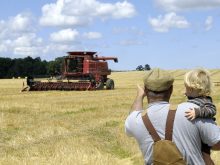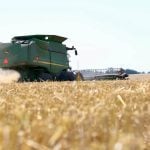Green manures increase the biochemical activity of the soil.
According to soil scientist Bix
Biederbeck of the Semiarid Prairie Agricultural Research Centre in Swift Current, Sask., more nitrogen and carbon is found in the soil in the bodies of microbes following the planting of a legume green manure crop.
Such a crop increases bacteria, filamentous fungi, yeast and nitrifying bacteria in the soil.
Biederbeck compared summerfallow-wheat rotations in the semiarid region of the Prairies to continuous wheat and green manure-wheat rotations. The green manures were lentil, flatpea, chickling vetch and field pea.
Read Also

Now is the time for Canada to rediscover its agricultural edge on the global stage
Beyond precision agriculture, the government must explore programs that help grow farmer income so that they have the required capital needed to invest in these technologies to see the eventual return on investment.
After three cycles of this rotation, which took six years, soil under continuous wheat improved compared to soil under fallow-wheat rotations. Soil under green manure-wheat rotations had the greatest improvements.
Continuous wheat returned more material to the soil than the fallow-wheat rotation, and this likely caused the improvement of the soil. However, the relative proportions of carbon and nitrogen are important. Wheat residues have a higher carbon to nitrogen ratio than legumes.
In Biederbeck’s study, soils after a fallow-wheat rotation had a carbon to nitrogen ratio of 80:1 while soils after green manure-wheat rotations had a carbon to nitrogen ratio of 35:1.
Soil microbes can be more active when there is a better balance between carbon and nitrogen. This likely caused the greater improvement of the soil seen after green manures.
Soil microbes are the basis of nutrient cycling in the soil. The increased activity of the soil microbes after green manure is especially important in organic agriculture, where cycled nutrients are not supplemented with chemical inputs.
Biederbeck found that organic carbon increased after legume green manure crops relative to cereal crops. This is not the case in every study. The difference may be that in Biederbeck’s study, the green manure produced nearly the same amount of biomass, and thus nearly the same amount of carbon, as the cereal.
In some studies, cereals are more productive than legumes. It may also be that the drier climate of Biederbeck’s study encouraged a greater root to shoot ratio.
Other studies show that carbon from root material persists in the soil longer than carbon from shoot material. The residues from shoots may be the main source of nitrogen for the crops following green manures. The residues from roots probably have more to do with improved soil structure.
These improvements reduce erosion potential, improve the soil’s ability to hold water and improve the ability of roots to penetrate through the soil. It is likely that much of the persistent organic matter in the soil is derived from roots.
Where moisture levels are sufficient, a perennial crop is more beneficial than an annual crop as a green manure.
Alison Nelson showed while she was a graduate student at the
University of Manitoba that perennial crops add much more organic matter to the soil than annual crops. She found that having perennials in rotation reduces the potential for wind and water erosion.
Nelson found that wet aggregate stability was higher on organic rotations than on conventional rotations at Carman, Man. Aggregate stability is the ability of soil particles to stick together and avoid erosion. Thus, the organic rotations were less prone to soil erosion.
Usually, improved resistance to erosion is associated with increased organic matter, but this was not the case at Carman. In fact, the opposite was true. Nelson suggested that the increased ability of the soil particles to stick together may have been the result of a different type of organic matter rather than an increase in the total amount of organic matter.
Arbuscular mycorrhizal fungi are frequently more common in organic systems, and these actively stabilize soil structure by producing polysaccharides, sticky types of carbohydrates that bind soil particles together.
Taken together, these studies add further evidence that including green manures in rotation will build soil structure, reduce erosion and increase soil’s biological function. Biological function is the essence of soil productivity in organic systems.
Frick is the prairie co-ordinator for the Organic Agriculture Centre of Canada located at the University of Saskatchewan. She can be reached at 306-966-4975, at brenda.frick@usask.ca, or www.organicagcentre.ca.














